Money Laundering Scandal in Commonwealth Bank of Australia
VerifiedAdded on 2023/06/08
|10
|2326
|314
AI Summary
This study describes Commonwealth Bank of Australia (CBA), its money laundering and fraudulence. It is an integrated financial service provider operating in Australia, New Zealand, Europe, and the Asia-Pacific region that has been accused of rupturing the Anti-Money Laundering and Counter-Terrorism Financing. The study analyzes the unethical or grossly incompetent conduct from the organizational failures. Annotated bibliography and conclusion included.
Contribute Materials
Your contribution can guide someone’s learning journey. Share your
documents today.
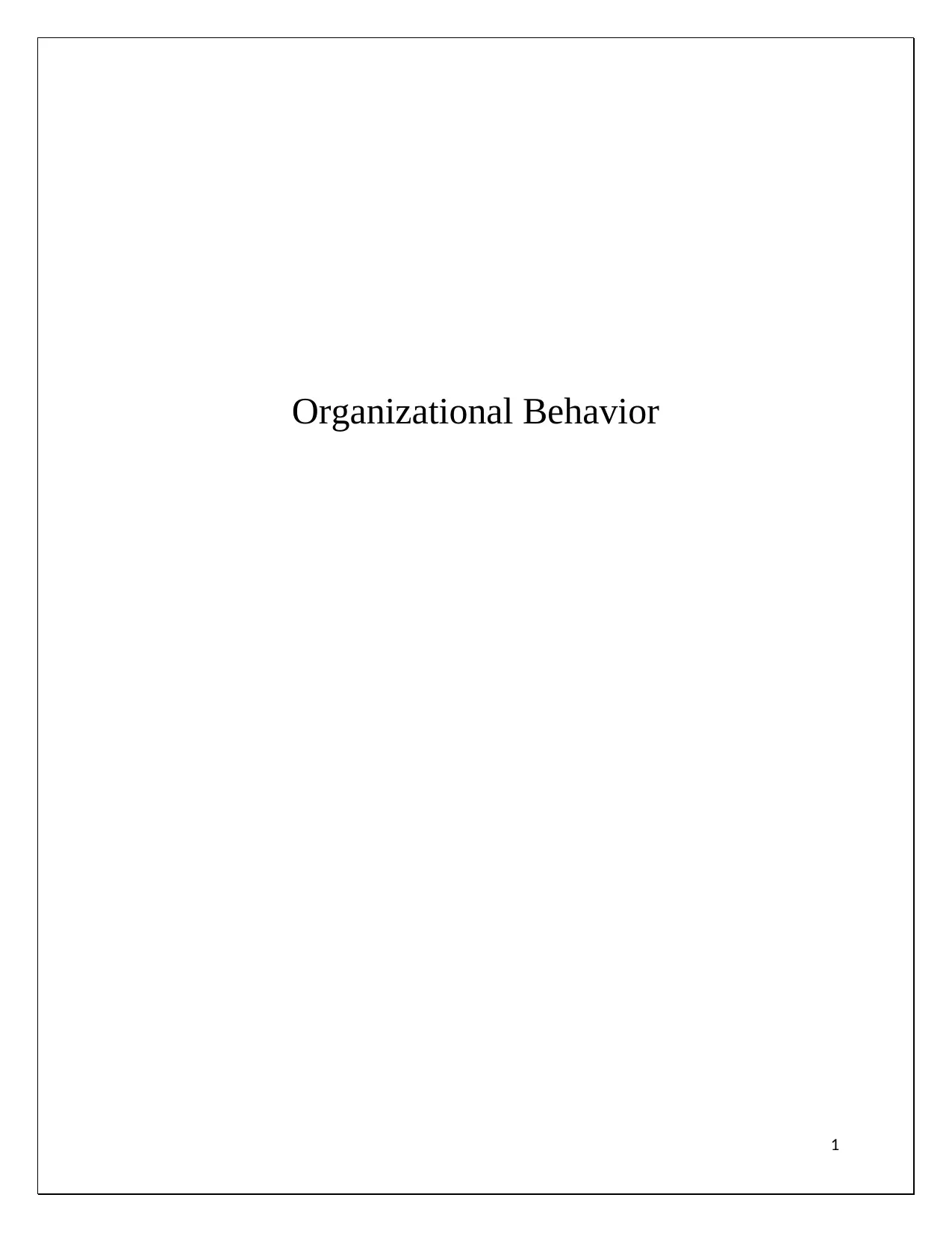
Organizational Behavior
1
1
Secure Best Marks with AI Grader
Need help grading? Try our AI Grader for instant feedback on your assignments.
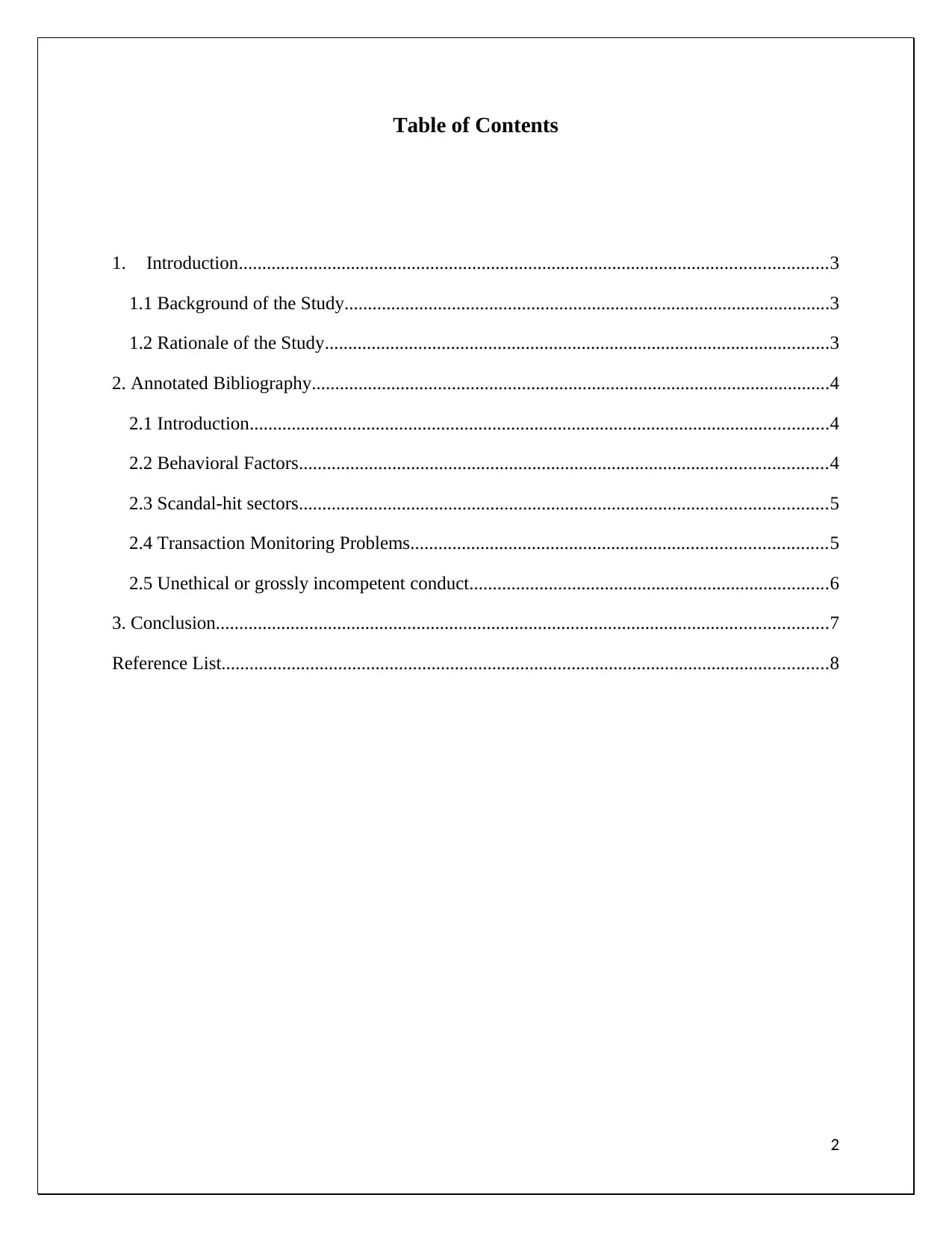
Table of Contents
1. Introduction..............................................................................................................................3
1.1 Background of the Study........................................................................................................3
1.2 Rationale of the Study............................................................................................................3
2. Annotated Bibliography...............................................................................................................4
2.1 Introduction............................................................................................................................4
2.2 Behavioral Factors.................................................................................................................4
2.3 Scandal-hit sectors.................................................................................................................5
2.4 Transaction Monitoring Problems.........................................................................................5
2.5 Unethical or grossly incompetent conduct.............................................................................6
3. Conclusion...................................................................................................................................7
Reference List..................................................................................................................................8
2
1. Introduction..............................................................................................................................3
1.1 Background of the Study........................................................................................................3
1.2 Rationale of the Study............................................................................................................3
2. Annotated Bibliography...............................................................................................................4
2.1 Introduction............................................................................................................................4
2.2 Behavioral Factors.................................................................................................................4
2.3 Scandal-hit sectors.................................................................................................................5
2.4 Transaction Monitoring Problems.........................................................................................5
2.5 Unethical or grossly incompetent conduct.............................................................................6
3. Conclusion...................................................................................................................................7
Reference List..................................................................................................................................8
2
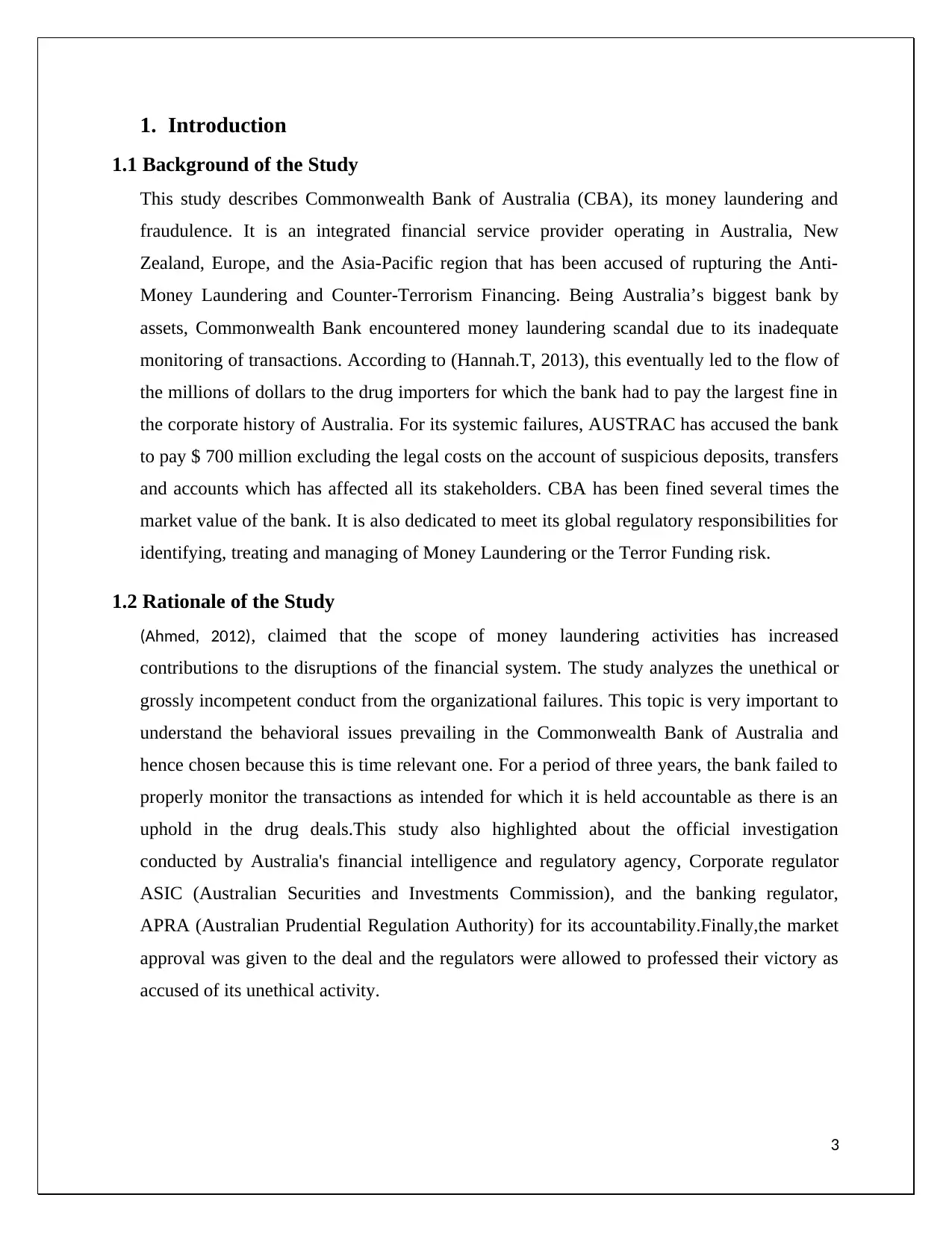
1. Introduction
1.1 Background of the Study
This study describes Commonwealth Bank of Australia (CBA), its money laundering and
fraudulence. It is an integrated financial service provider operating in Australia, New
Zealand, Europe, and the Asia-Pacific region that has been accused of rupturing the Anti-
Money Laundering and Counter-Terrorism Financing. Being Australia’s biggest bank by
assets, Commonwealth Bank encountered money laundering scandal due to its inadequate
monitoring of transactions. According to (Hannah.T, 2013), this eventually led to the flow of
the millions of dollars to the drug importers for which the bank had to pay the largest fine in
the corporate history of Australia. For its systemic failures, AUSTRAC has accused the bank
to pay $ 700 million excluding the legal costs on the account of suspicious deposits, transfers
and accounts which has affected all its stakeholders. CBA has been fined several times the
market value of the bank. It is also dedicated to meet its global regulatory responsibilities for
identifying, treating and managing of Money Laundering or the Terror Funding risk.
1.2 Rationale of the Study
(Ahmed, 2012), claimed that the scope of money laundering activities has increased
contributions to the disruptions of the financial system. The study analyzes the unethical or
grossly incompetent conduct from the organizational failures. This topic is very important to
understand the behavioral issues prevailing in the Commonwealth Bank of Australia and
hence chosen because this is time relevant one. For a period of three years, the bank failed to
properly monitor the transactions as intended for which it is held accountable as there is an
uphold in the drug deals.This study also highlighted about the official investigation
conducted by Australia's financial intelligence and regulatory agency, Corporate regulator
ASIC (Australian Securities and Investments Commission), and the banking regulator,
APRA (Australian Prudential Regulation Authority) for its accountability.Finally,the market
approval was given to the deal and the regulators were allowed to professed their victory as
accused of its unethical activity.
3
1.1 Background of the Study
This study describes Commonwealth Bank of Australia (CBA), its money laundering and
fraudulence. It is an integrated financial service provider operating in Australia, New
Zealand, Europe, and the Asia-Pacific region that has been accused of rupturing the Anti-
Money Laundering and Counter-Terrorism Financing. Being Australia’s biggest bank by
assets, Commonwealth Bank encountered money laundering scandal due to its inadequate
monitoring of transactions. According to (Hannah.T, 2013), this eventually led to the flow of
the millions of dollars to the drug importers for which the bank had to pay the largest fine in
the corporate history of Australia. For its systemic failures, AUSTRAC has accused the bank
to pay $ 700 million excluding the legal costs on the account of suspicious deposits, transfers
and accounts which has affected all its stakeholders. CBA has been fined several times the
market value of the bank. It is also dedicated to meet its global regulatory responsibilities for
identifying, treating and managing of Money Laundering or the Terror Funding risk.
1.2 Rationale of the Study
(Ahmed, 2012), claimed that the scope of money laundering activities has increased
contributions to the disruptions of the financial system. The study analyzes the unethical or
grossly incompetent conduct from the organizational failures. This topic is very important to
understand the behavioral issues prevailing in the Commonwealth Bank of Australia and
hence chosen because this is time relevant one. For a period of three years, the bank failed to
properly monitor the transactions as intended for which it is held accountable as there is an
uphold in the drug deals.This study also highlighted about the official investigation
conducted by Australia's financial intelligence and regulatory agency, Corporate regulator
ASIC (Australian Securities and Investments Commission), and the banking regulator,
APRA (Australian Prudential Regulation Authority) for its accountability.Finally,the market
approval was given to the deal and the regulators were allowed to professed their victory as
accused of its unethical activity.
3
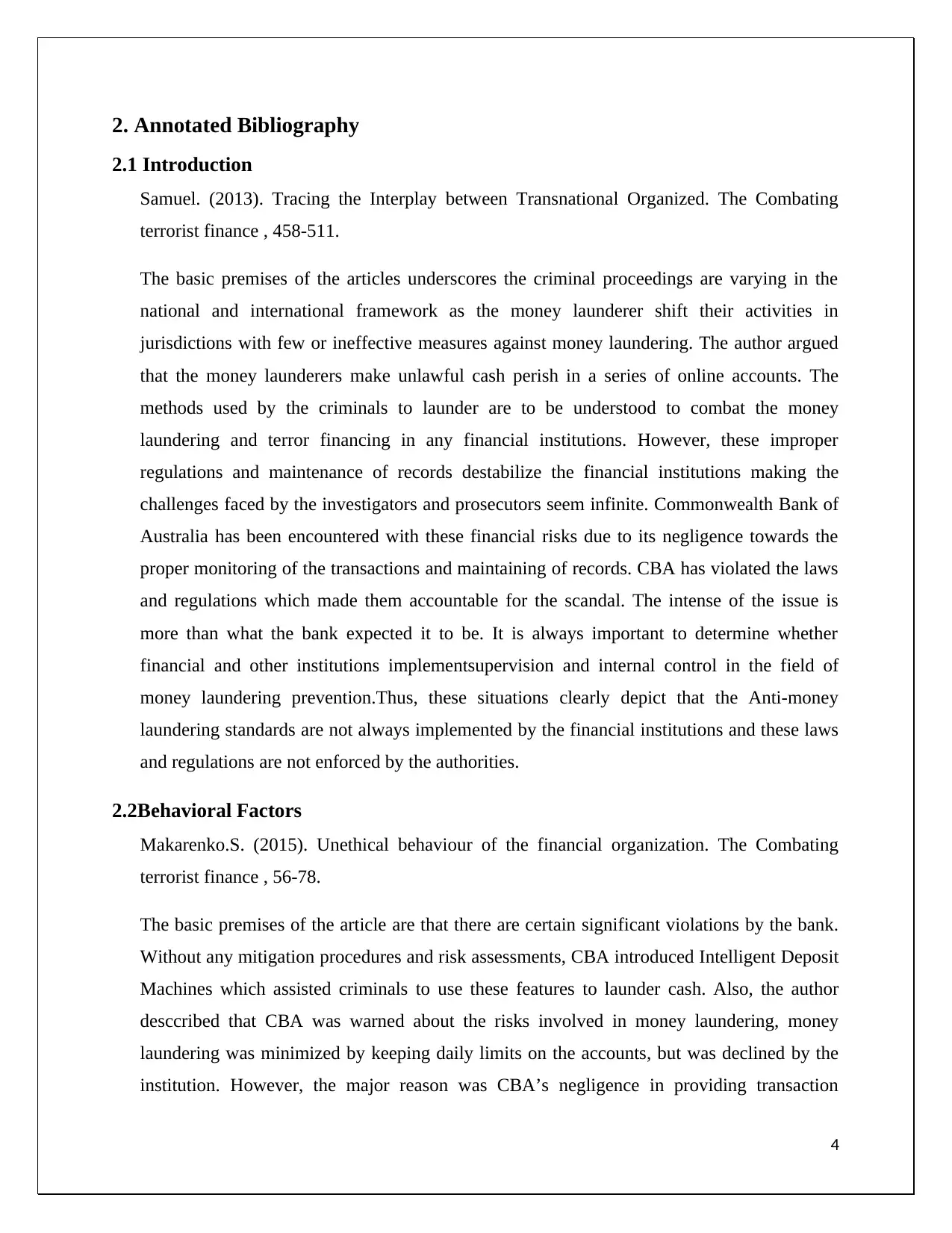
2. Annotated Bibliography
2.1 Introduction
Samuel. (2013). Tracing the Interplay between Transnational Organized. The Combating
terrorist finance , 458-511.
The basic premises of the articles underscores the criminal proceedings are varying in the
national and international framework as the money launderer shift their activities in
jurisdictions with few or ineffective measures against money laundering. The author argued
that the money launderers make unlawful cash perish in a series of online accounts. The
methods used by the criminals to launder are to be understood to combat the money
laundering and terror financing in any financial institutions. However, these improper
regulations and maintenance of records destabilize the financial institutions making the
challenges faced by the investigators and prosecutors seem infinite. Commonwealth Bank of
Australia has been encountered with these financial risks due to its negligence towards the
proper monitoring of the transactions and maintaining of records. CBA has violated the laws
and regulations which made them accountable for the scandal. The intense of the issue is
more than what the bank expected it to be. It is always important to determine whether
financial and other institutions implementsupervision and internal control in the field of
money laundering prevention.Thus, these situations clearly depict that the Anti-money
laundering standards are not always implemented by the financial institutions and these laws
and regulations are not enforced by the authorities.
2.2Behavioral Factors
Makarenko.S. (2015). Unethical behaviour of the financial organization. The Combating
terrorist finance , 56-78.
The basic premises of the article are that there are certain significant violations by the bank.
Without any mitigation procedures and risk assessments, CBA introduced Intelligent Deposit
Machines which assisted criminals to use these features to launder cash. Also, the author
desccribed that CBA was warned about the risks involved in money laundering, money
laundering was minimized by keeping daily limits on the accounts, but was declined by the
institution. However, the major reason was CBA’s negligence in providing transaction
4
2.1 Introduction
Samuel. (2013). Tracing the Interplay between Transnational Organized. The Combating
terrorist finance , 458-511.
The basic premises of the articles underscores the criminal proceedings are varying in the
national and international framework as the money launderer shift their activities in
jurisdictions with few or ineffective measures against money laundering. The author argued
that the money launderers make unlawful cash perish in a series of online accounts. The
methods used by the criminals to launder are to be understood to combat the money
laundering and terror financing in any financial institutions. However, these improper
regulations and maintenance of records destabilize the financial institutions making the
challenges faced by the investigators and prosecutors seem infinite. Commonwealth Bank of
Australia has been encountered with these financial risks due to its negligence towards the
proper monitoring of the transactions and maintaining of records. CBA has violated the laws
and regulations which made them accountable for the scandal. The intense of the issue is
more than what the bank expected it to be. It is always important to determine whether
financial and other institutions implementsupervision and internal control in the field of
money laundering prevention.Thus, these situations clearly depict that the Anti-money
laundering standards are not always implemented by the financial institutions and these laws
and regulations are not enforced by the authorities.
2.2Behavioral Factors
Makarenko.S. (2015). Unethical behaviour of the financial organization. The Combating
terrorist finance , 56-78.
The basic premises of the article are that there are certain significant violations by the bank.
Without any mitigation procedures and risk assessments, CBA introduced Intelligent Deposit
Machines which assisted criminals to use these features to launder cash. Also, the author
desccribed that CBA was warned about the risks involved in money laundering, money
laundering was minimized by keeping daily limits on the accounts, but was declined by the
institution. However, the major reason was CBA’s negligence in providing transaction
4
Secure Best Marks with AI Grader
Need help grading? Try our AI Grader for instant feedback on your assignments.
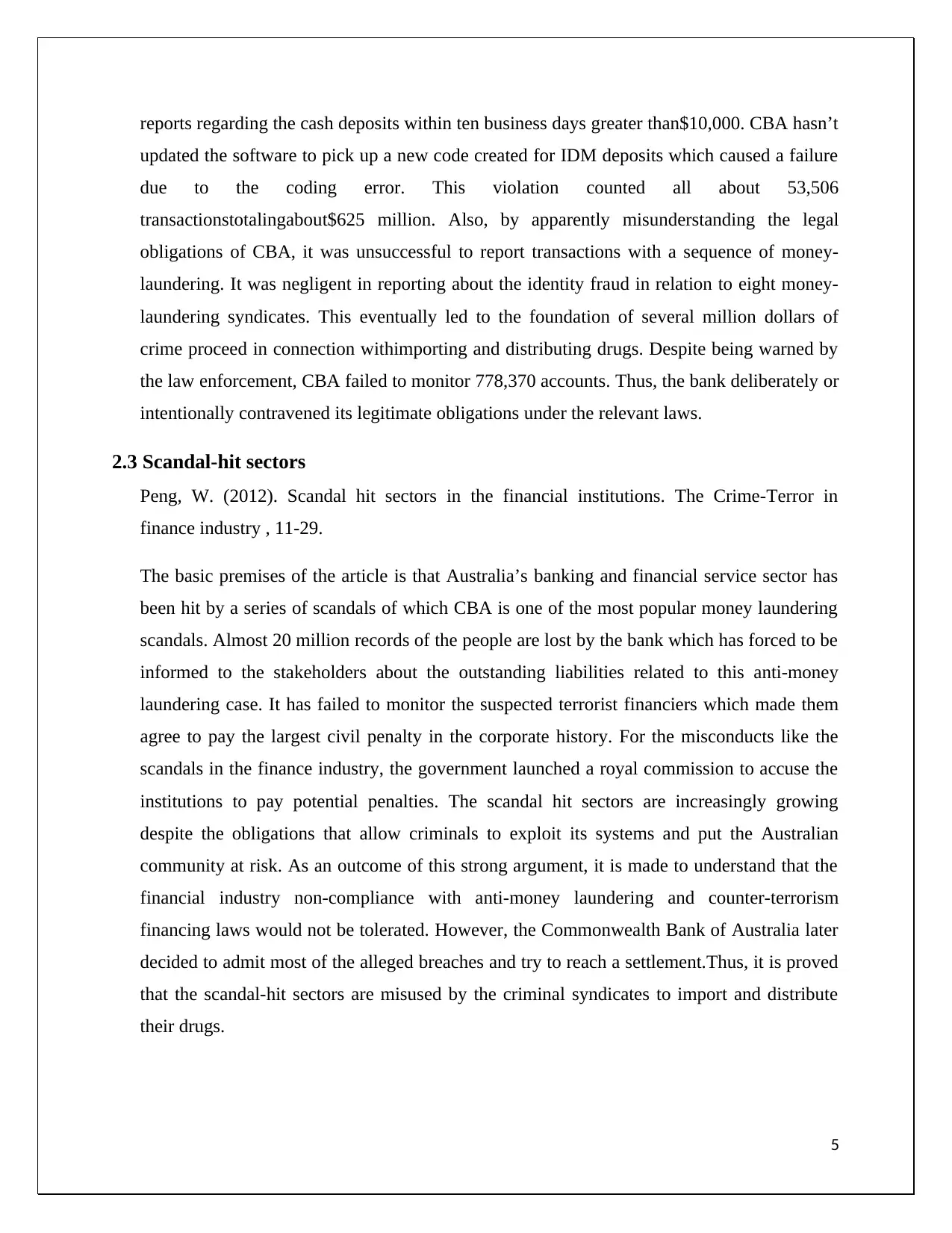
reports regarding the cash deposits within ten business days greater than$10,000. CBA hasn’t
updated the software to pick up a new code created for IDM deposits which caused a failure
due to the coding error. This violation counted all about 53,506
transactionstotalingabout$625 million. Also, by apparently misunderstanding the legal
obligations of CBA, it was unsuccessful to report transactions with a sequence of money-
laundering. It was negligent in reporting about the identity fraud in relation to eight money-
laundering syndicates. This eventually led to the foundation of several million dollars of
crime proceed in connection withimporting and distributing drugs. Despite being warned by
the law enforcement, CBA failed to monitor 778,370 accounts. Thus, the bank deliberately or
intentionally contravened its legitimate obligations under the relevant laws.
2.3 Scandal-hit sectors
Peng, W. (2012). Scandal hit sectors in the financial institutions. The Crime-Terror in
finance industry , 11-29.
The basic premises of the article is that Australia’s banking and financial service sector has
been hit by a series of scandals of which CBA is one of the most popular money laundering
scandals. Almost 20 million records of the people are lost by the bank which has forced to be
informed to the stakeholders about the outstanding liabilities related to this anti-money
laundering case. It has failed to monitor the suspected terrorist financiers which made them
agree to pay the largest civil penalty in the corporate history. For the misconducts like the
scandals in the finance industry, the government launched a royal commission to accuse the
institutions to pay potential penalties. The scandal hit sectors are increasingly growing
despite the obligations that allow criminals to exploit its systems and put the Australian
community at risk. As an outcome of this strong argument, it is made to understand that the
financial industry non-compliance with anti-money laundering and counter-terrorism
financing laws would not be tolerated. However, the Commonwealth Bank of Australia later
decided to admit most of the alleged breaches and try to reach a settlement.Thus, it is proved
that the scandal-hit sectors are misused by the criminal syndicates to import and distribute
their drugs.
5
updated the software to pick up a new code created for IDM deposits which caused a failure
due to the coding error. This violation counted all about 53,506
transactionstotalingabout$625 million. Also, by apparently misunderstanding the legal
obligations of CBA, it was unsuccessful to report transactions with a sequence of money-
laundering. It was negligent in reporting about the identity fraud in relation to eight money-
laundering syndicates. This eventually led to the foundation of several million dollars of
crime proceed in connection withimporting and distributing drugs. Despite being warned by
the law enforcement, CBA failed to monitor 778,370 accounts. Thus, the bank deliberately or
intentionally contravened its legitimate obligations under the relevant laws.
2.3 Scandal-hit sectors
Peng, W. (2012). Scandal hit sectors in the financial institutions. The Crime-Terror in
finance industry , 11-29.
The basic premises of the article is that Australia’s banking and financial service sector has
been hit by a series of scandals of which CBA is one of the most popular money laundering
scandals. Almost 20 million records of the people are lost by the bank which has forced to be
informed to the stakeholders about the outstanding liabilities related to this anti-money
laundering case. It has failed to monitor the suspected terrorist financiers which made them
agree to pay the largest civil penalty in the corporate history. For the misconducts like the
scandals in the finance industry, the government launched a royal commission to accuse the
institutions to pay potential penalties. The scandal hit sectors are increasingly growing
despite the obligations that allow criminals to exploit its systems and put the Australian
community at risk. As an outcome of this strong argument, it is made to understand that the
financial industry non-compliance with anti-money laundering and counter-terrorism
financing laws would not be tolerated. However, the Commonwealth Bank of Australia later
decided to admit most of the alleged breaches and try to reach a settlement.Thus, it is proved
that the scandal-hit sectors are misused by the criminal syndicates to import and distribute
their drugs.
5
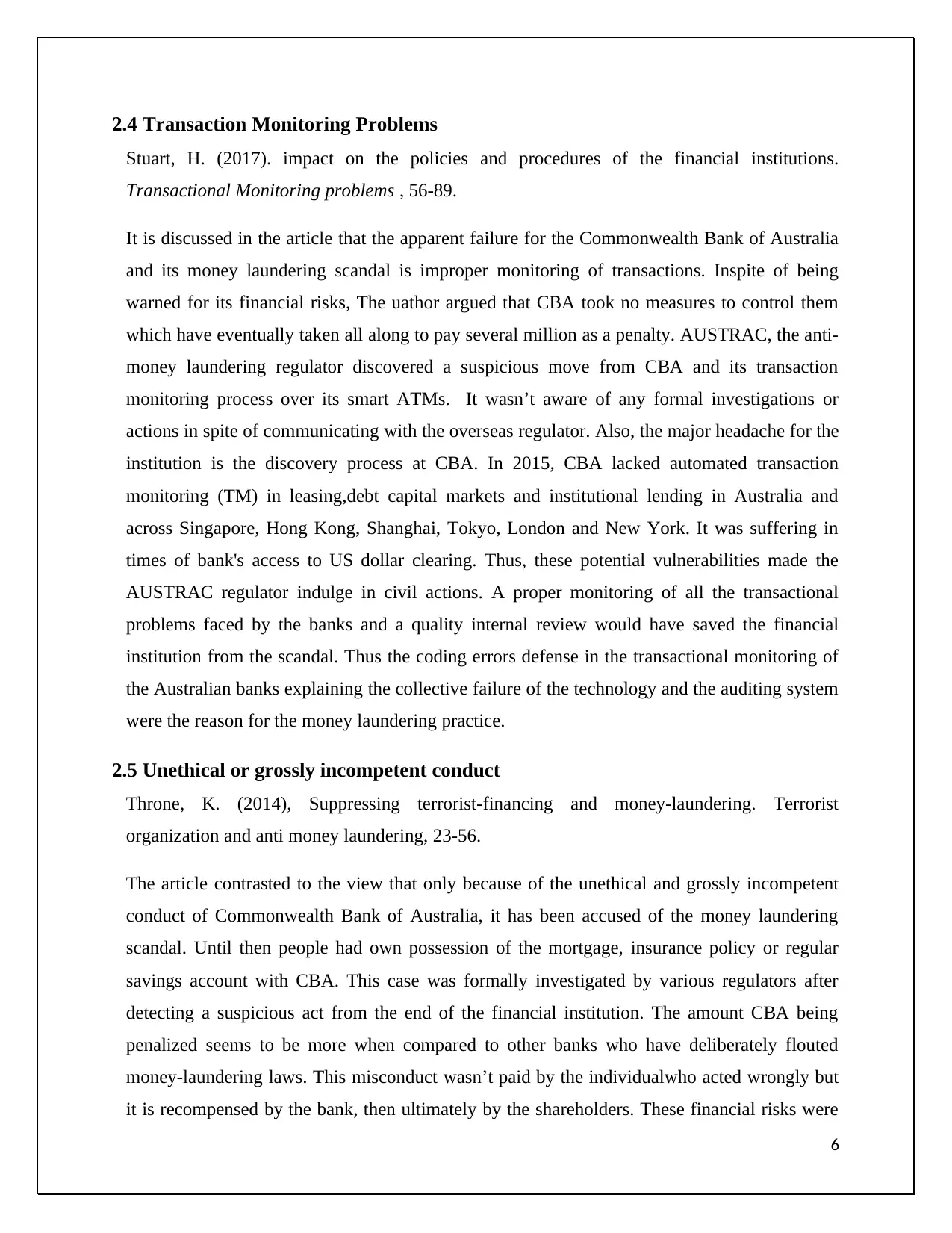
2.4 Transaction Monitoring Problems
Stuart, H. (2017). impact on the policies and procedures of the financial institutions.
Transactional Monitoring problems , 56-89.
It is discussed in the article that the apparent failure for the Commonwealth Bank of Australia
and its money laundering scandal is improper monitoring of transactions. Inspite of being
warned for its financial risks, The uathor argued that CBA took no measures to control them
which have eventually taken all along to pay several million as a penalty. AUSTRAC, the anti-
money laundering regulator discovered a suspicious move from CBA and its transaction
monitoring process over its smart ATMs. It wasn’t aware of any formal investigations or
actions in spite of communicating with the overseas regulator. Also, the major headache for the
institution is the discovery process at CBA. In 2015, CBA lacked automated transaction
monitoring (TM) in leasing,debt capital markets and institutional lending in Australia and
across Singapore, Hong Kong, Shanghai, Tokyo, London and New York. It was suffering in
times of bank's access to US dollar clearing. Thus, these potential vulnerabilities made the
AUSTRAC regulator indulge in civil actions. A proper monitoring of all the transactional
problems faced by the banks and a quality internal review would have saved the financial
institution from the scandal. Thus the coding errors defense in the transactional monitoring of
the Australian banks explaining the collective failure of the technology and the auditing system
were the reason for the money laundering practice.
2.5 Unethical or grossly incompetent conduct
Throne, K. (2014), Suppressing terrorist-financing and money-laundering. Terrorist
organization and anti money laundering, 23-56.
The article contrasted to the view that only because of the unethical and grossly incompetent
conduct of Commonwealth Bank of Australia, it has been accused of the money laundering
scandal. Until then people had own possession of the mortgage, insurance policy or regular
savings account with CBA. This case was formally investigated by various regulators after
detecting a suspicious act from the end of the financial institution. The amount CBA being
penalized seems to be more when compared to other banks who have deliberately flouted
money-laundering laws. This misconduct wasn’t paid by the individualwho acted wrongly but
it is recompensed by the bank, then ultimately by the shareholders. These financial risks were
6
Stuart, H. (2017). impact on the policies and procedures of the financial institutions.
Transactional Monitoring problems , 56-89.
It is discussed in the article that the apparent failure for the Commonwealth Bank of Australia
and its money laundering scandal is improper monitoring of transactions. Inspite of being
warned for its financial risks, The uathor argued that CBA took no measures to control them
which have eventually taken all along to pay several million as a penalty. AUSTRAC, the anti-
money laundering regulator discovered a suspicious move from CBA and its transaction
monitoring process over its smart ATMs. It wasn’t aware of any formal investigations or
actions in spite of communicating with the overseas regulator. Also, the major headache for the
institution is the discovery process at CBA. In 2015, CBA lacked automated transaction
monitoring (TM) in leasing,debt capital markets and institutional lending in Australia and
across Singapore, Hong Kong, Shanghai, Tokyo, London and New York. It was suffering in
times of bank's access to US dollar clearing. Thus, these potential vulnerabilities made the
AUSTRAC regulator indulge in civil actions. A proper monitoring of all the transactional
problems faced by the banks and a quality internal review would have saved the financial
institution from the scandal. Thus the coding errors defense in the transactional monitoring of
the Australian banks explaining the collective failure of the technology and the auditing system
were the reason for the money laundering practice.
2.5 Unethical or grossly incompetent conduct
Throne, K. (2014), Suppressing terrorist-financing and money-laundering. Terrorist
organization and anti money laundering, 23-56.
The article contrasted to the view that only because of the unethical and grossly incompetent
conduct of Commonwealth Bank of Australia, it has been accused of the money laundering
scandal. Until then people had own possession of the mortgage, insurance policy or regular
savings account with CBA. This case was formally investigated by various regulators after
detecting a suspicious act from the end of the financial institution. The amount CBA being
penalized seems to be more when compared to other banks who have deliberately flouted
money-laundering laws. This misconduct wasn’t paid by the individualwho acted wrongly but
it is recompensed by the bank, then ultimately by the shareholders. These financial risks were
6
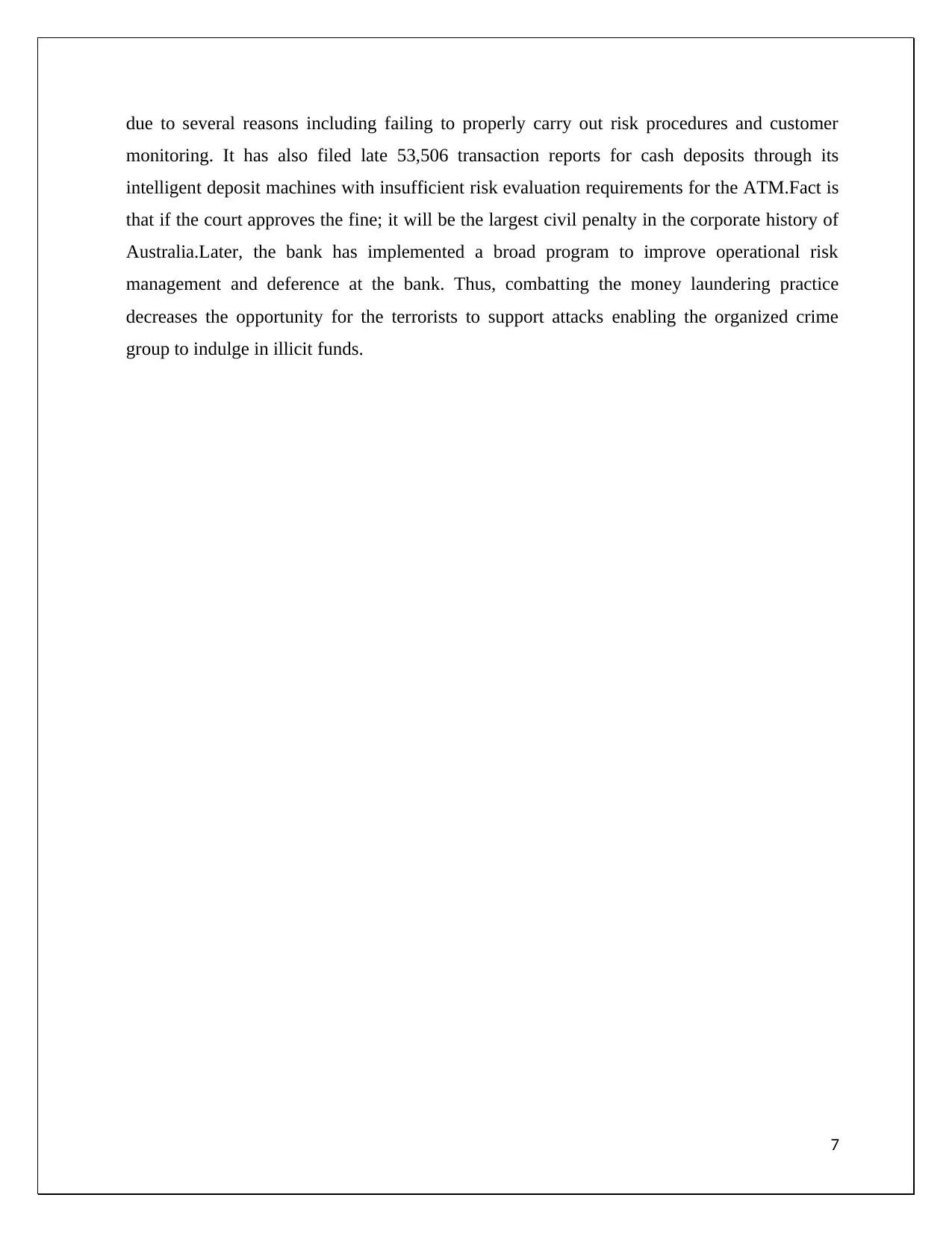
due to several reasons including failing to properly carry out risk procedures and customer
monitoring. It has also filed late 53,506 transaction reports for cash deposits through its
intelligent deposit machines with insufficient risk evaluation requirements for the ATM.Fact is
that if the court approves the fine; it will be the largest civil penalty in the corporate history of
Australia.Later, the bank has implemented a broad program to improve operational risk
management and deference at the bank. Thus, combatting the money laundering practice
decreases the opportunity for the terrorists to support attacks enabling the organized crime
group to indulge in illicit funds.
7
monitoring. It has also filed late 53,506 transaction reports for cash deposits through its
intelligent deposit machines with insufficient risk evaluation requirements for the ATM.Fact is
that if the court approves the fine; it will be the largest civil penalty in the corporate history of
Australia.Later, the bank has implemented a broad program to improve operational risk
management and deference at the bank. Thus, combatting the money laundering practice
decreases the opportunity for the terrorists to support attacks enabling the organized crime
group to indulge in illicit funds.
7
Paraphrase This Document
Need a fresh take? Get an instant paraphrase of this document with our AI Paraphraser
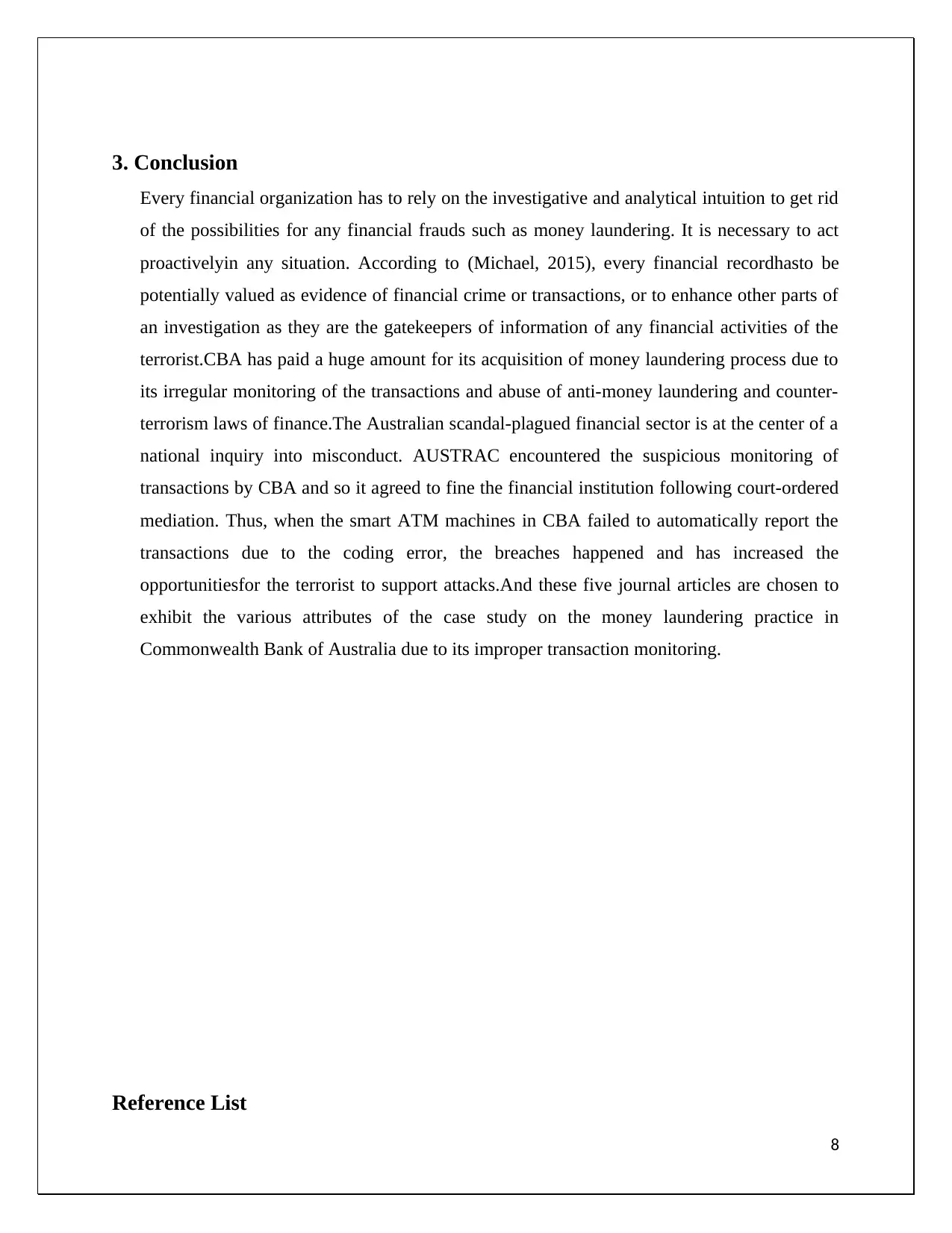
3. Conclusion
Every financial organization has to rely on the investigative and analytical intuition to get rid
of the possibilities for any financial frauds such as money laundering. It is necessary to act
proactivelyin any situation. According to (Michael, 2015), every financial recordhasto be
potentially valued as evidence of financial crime or transactions, or to enhance other parts of
an investigation as they are the gatekeepers of information of any financial activities of the
terrorist.CBA has paid a huge amount for its acquisition of money laundering process due to
its irregular monitoring of the transactions and abuse of anti-money laundering and counter-
terrorism laws of finance.The Australian scandal-plagued financial sector is at the center of a
national inquiry into misconduct. AUSTRAC encountered the suspicious monitoring of
transactions by CBA and so it agreed to fine the financial institution following court-ordered
mediation. Thus, when the smart ATM machines in CBA failed to automatically report the
transactions due to the coding error, the breaches happened and has increased the
opportunitiesfor the terrorist to support attacks.And these five journal articles are chosen to
exhibit the various attributes of the case study on the money laundering practice in
Commonwealth Bank of Australia due to its improper transaction monitoring.
Reference List
8
Every financial organization has to rely on the investigative and analytical intuition to get rid
of the possibilities for any financial frauds such as money laundering. It is necessary to act
proactivelyin any situation. According to (Michael, 2015), every financial recordhasto be
potentially valued as evidence of financial crime or transactions, or to enhance other parts of
an investigation as they are the gatekeepers of information of any financial activities of the
terrorist.CBA has paid a huge amount for its acquisition of money laundering process due to
its irregular monitoring of the transactions and abuse of anti-money laundering and counter-
terrorism laws of finance.The Australian scandal-plagued financial sector is at the center of a
national inquiry into misconduct. AUSTRAC encountered the suspicious monitoring of
transactions by CBA and so it agreed to fine the financial institution following court-ordered
mediation. Thus, when the smart ATM machines in CBA failed to automatically report the
transactions due to the coding error, the breaches happened and has increased the
opportunitiesfor the terrorist to support attacks.And these five journal articles are chosen to
exhibit the various attributes of the case study on the money laundering practice in
Commonwealth Bank of Australia due to its improper transaction monitoring.
Reference List
8
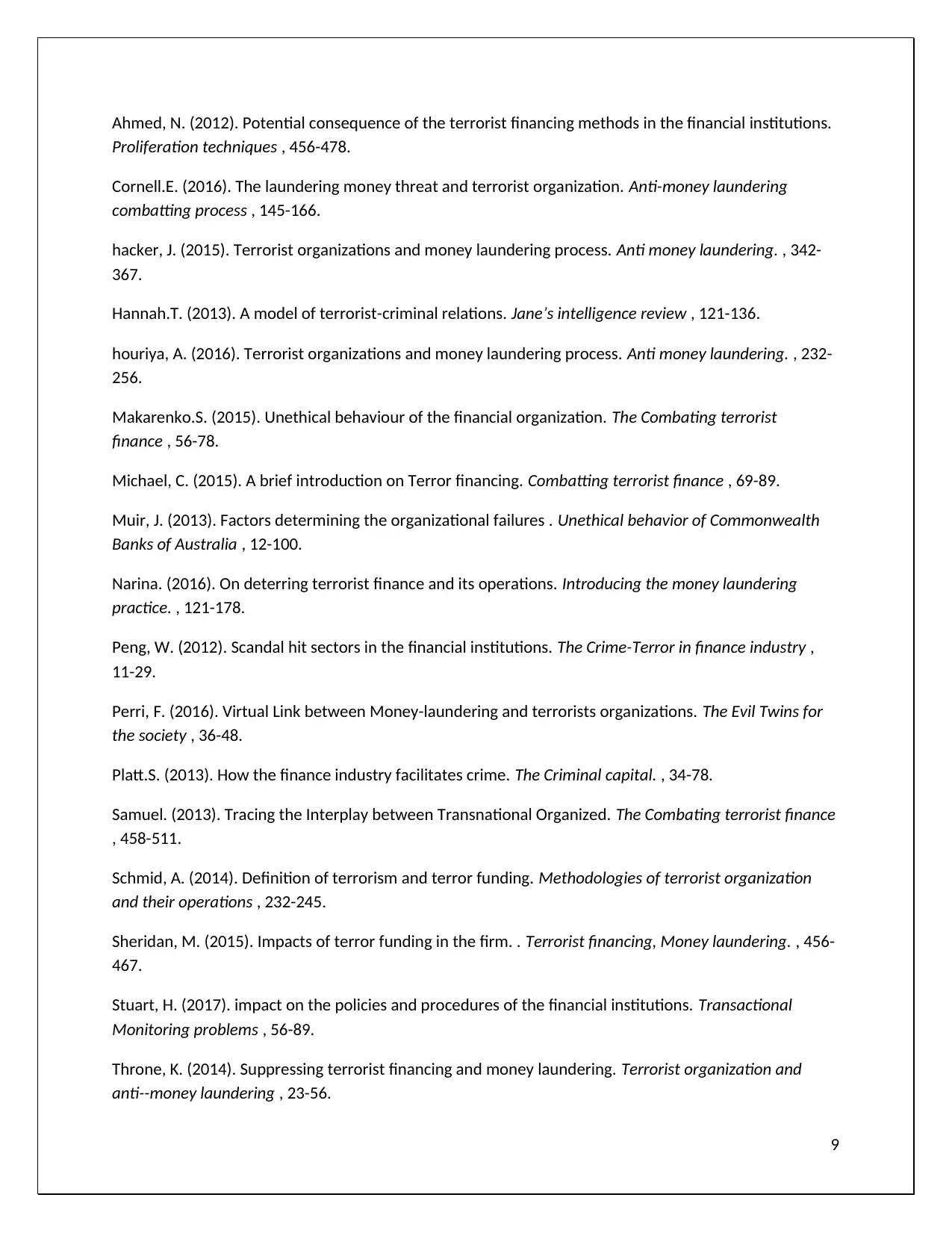
Ahmed, N. (2012). Potential consequence of the terrorist financing methods in the financial institutions.
Proliferation techniques , 456-478.
Cornell.E. (2016). The laundering money threat and terrorist organization. Anti-money laundering
combatting process , 145-166.
hacker, J. (2015). Terrorist organizations and money laundering process. Anti money laundering. , 342-
367.
Hannah.T. (2013). A model of terrorist-criminal relations. Jane’s intelligence review , 121-136.
houriya, A. (2016). Terrorist organizations and money laundering process. Anti money laundering. , 232-
256.
Makarenko.S. (2015). Unethical behaviour of the financial organization. The Combating terrorist
finance , 56-78.
Michael, C. (2015). A brief introduction on Terror financing. Combatting terrorist finance , 69-89.
Muir, J. (2013). Factors determining the organizational failures . Unethical behavior of Commonwealth
Banks of Australia , 12-100.
Narina. (2016). On deterring terrorist finance and its operations. Introducing the money laundering
practice. , 121-178.
Peng, W. (2012). Scandal hit sectors in the financial institutions. The Crime-Terror in finance industry ,
11-29.
Perri, F. (2016). Virtual Link between Money-laundering and terrorists organizations. The Evil Twins for
the society , 36-48.
Platt.S. (2013). How the finance industry facilitates crime. The Criminal capital. , 34-78.
Samuel. (2013). Tracing the Interplay between Transnational Organized. The Combating terrorist finance
, 458-511.
Schmid, A. (2014). Definition of terrorism and terror funding. Methodologies of terrorist organization
and their operations , 232-245.
Sheridan, M. (2015). Impacts of terror funding in the firm. . Terrorist financing, Money laundering. , 456-
467.
Stuart, H. (2017). impact on the policies and procedures of the financial institutions. Transactional
Monitoring problems , 56-89.
Throne, K. (2014). Suppressing terrorist financing and money laundering. Terrorist organization and
anti--money laundering , 23-56.
9
Proliferation techniques , 456-478.
Cornell.E. (2016). The laundering money threat and terrorist organization. Anti-money laundering
combatting process , 145-166.
hacker, J. (2015). Terrorist organizations and money laundering process. Anti money laundering. , 342-
367.
Hannah.T. (2013). A model of terrorist-criminal relations. Jane’s intelligence review , 121-136.
houriya, A. (2016). Terrorist organizations and money laundering process. Anti money laundering. , 232-
256.
Makarenko.S. (2015). Unethical behaviour of the financial organization. The Combating terrorist
finance , 56-78.
Michael, C. (2015). A brief introduction on Terror financing. Combatting terrorist finance , 69-89.
Muir, J. (2013). Factors determining the organizational failures . Unethical behavior of Commonwealth
Banks of Australia , 12-100.
Narina. (2016). On deterring terrorist finance and its operations. Introducing the money laundering
practice. , 121-178.
Peng, W. (2012). Scandal hit sectors in the financial institutions. The Crime-Terror in finance industry ,
11-29.
Perri, F. (2016). Virtual Link between Money-laundering and terrorists organizations. The Evil Twins for
the society , 36-48.
Platt.S. (2013). How the finance industry facilitates crime. The Criminal capital. , 34-78.
Samuel. (2013). Tracing the Interplay between Transnational Organized. The Combating terrorist finance
, 458-511.
Schmid, A. (2014). Definition of terrorism and terror funding. Methodologies of terrorist organization
and their operations , 232-245.
Sheridan, M. (2015). Impacts of terror funding in the firm. . Terrorist financing, Money laundering. , 456-
467.
Stuart, H. (2017). impact on the policies and procedures of the financial institutions. Transactional
Monitoring problems , 56-89.
Throne, K. (2014). Suppressing terrorist financing and money laundering. Terrorist organization and
anti--money laundering , 23-56.
9
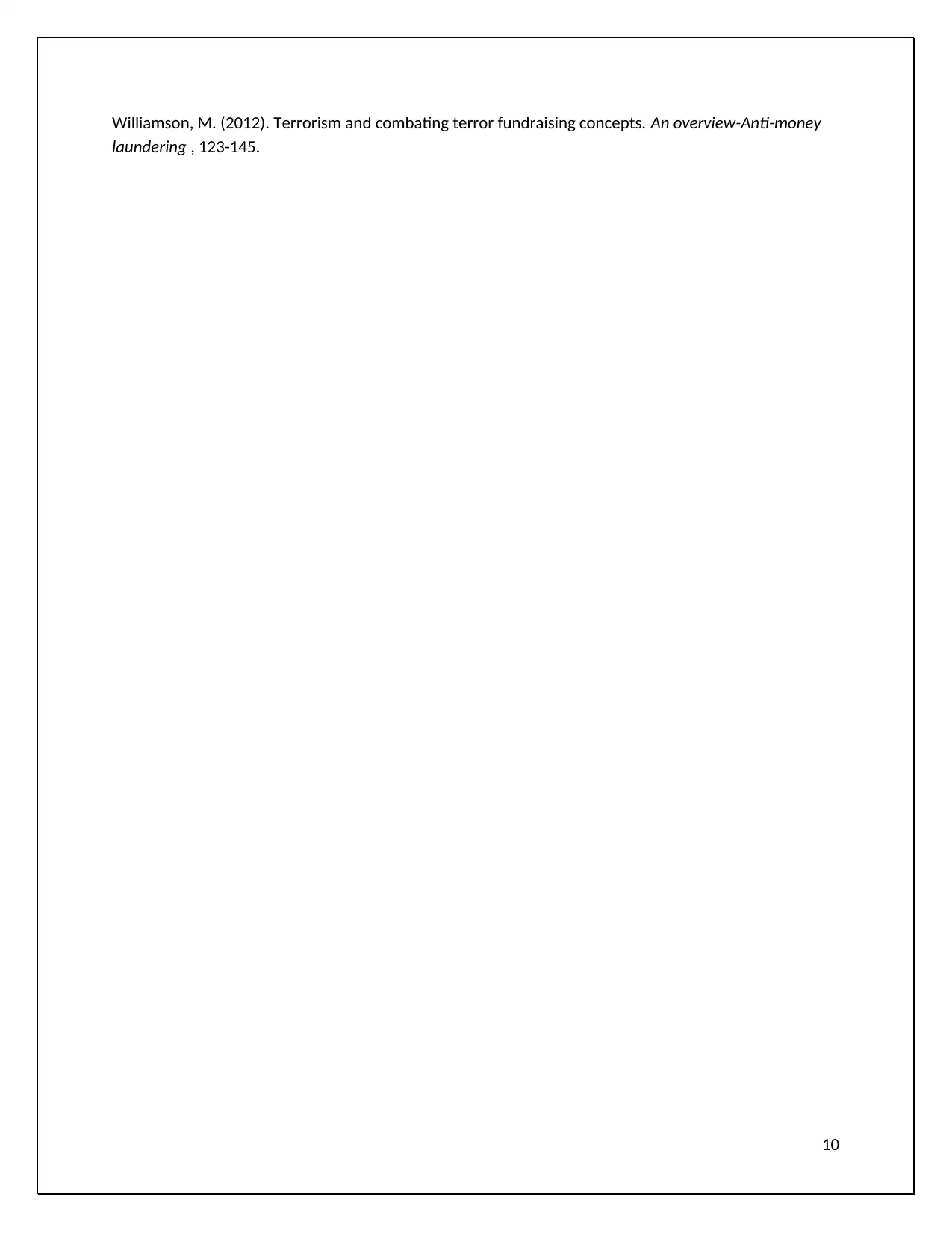
Williamson, M. (2012). Terrorism and combating terror fundraising concepts. An overview-Anti-money
laundering , 123-145.
10
laundering , 123-145.
10
1 out of 10
Related Documents
Your All-in-One AI-Powered Toolkit for Academic Success.
+13062052269
info@desklib.com
Available 24*7 on WhatsApp / Email
![[object Object]](/_next/static/media/star-bottom.7253800d.svg)
Unlock your academic potential
© 2024 | Zucol Services PVT LTD | All rights reserved.




